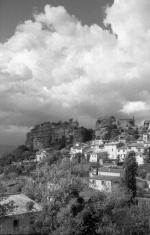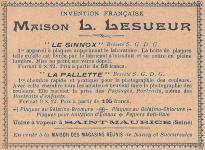|
Lesueur Sinnox |
Manufactured or assembled in France from (Before) 1901 to (After) 1901.
Index of rarity in France: Rare (among non-specialized garage sales)
Inventory number: 2199
See the complete technical specifications
Chronology of cameras Lesueur
(Photo-Gazette 1901)
To load a camera with glass plates in full light, and to unload it in the same conditions is the goal for the Sinnox, invented by Mr. Bercegal and built by M. Lesueur.
The idea is to make a special package containing 12 plates, so that box as just bought from the merchant has to put in the camera, , and when the 12 plates are exposed they are repacked in the same box, which is pulled out from the drawer unit and replaced with another.
The boxes are formed of two parts sliding one into another, as a cigar case, but the part that slides inside the other has, on one side, an opening of the size of a plate;each plate is separated from the others by a black paper on which it is adhered; the 12 papers are attached to the top of the inner part; down they slightly exceed the plate and are dubbed in thickness to be more robust. If a pin is passed through the entire box to pierce all papers in their lower part, and then pulling on the two sides of the box, all plates become detached from the upper part to accompany in its stroke thelower part of the case. However, care was taken to cut the paper at the lower end so that they overlap in steps, that is to say the first plate leaving about 1 cm not covered by the other eleven, the second plate leaving about 2 cm, the remainder being covered by the following ten and so on. We understand that as a result of this arrangement, it may result in more or less plates taken depending on where the pin is placed.
This is the principle of the Sinnox. In practice, the boxes are placed in a drawer provided in the camera to receive them, and they are provided at the top edge with a small cardboard that holds the inner part fixed when pulling the drawer; the cardboard carries a series of holes arranged next to each other, in which can be inserted a needle provided with a wood head and attached by a chain to the camera. From what we have said above, it is possible to move a given number of plates when opening the drawer. Things are arranged so that the hole 1 only pulls a sheet of black paper which masked the first plate; With the hole No. 2 we pull the paper attached to the plate No. 1, (the one just exposed), and, opening the drawer, it unmasks the plate 2; and so on, the exposed plates coming back each time in their place when you close the drawer. If we did expose only one, two or three plates, one can always remove the box from the camera and process them, then put the box back in place to expose the rest.
The manufacturer did not want to impose the brand of the plates it manufactured and took agreement with the most famous other companies, such as MM. Lumière, Guilleminot, Jougla, etc., to produce boxes for Sinnox. Finally, for the case where one would like to use any brand, a box is supplied fitted with small metal frames arranged in such a way to replace the paper supporting the plates in the original boxes.
The camera is arranged so that, automatically, the lens moves from a distance corresponding to the thickness of a plate each time the drawer is actuated so that it is always in focus for the plate exposed.
It is, in short, a very ingenious camera, which is required to give the same loading and unloading easiness using plates as those provided at the time for roll films.

Interesting links or bibliography :
Add a link or element of bibliography, a picture taken with this camera, a picture of box or an ads about this camera
Your photos taken with the same camera:
Cameras from Ebay France (Lesueur) (Uploaded each 3 hours)








